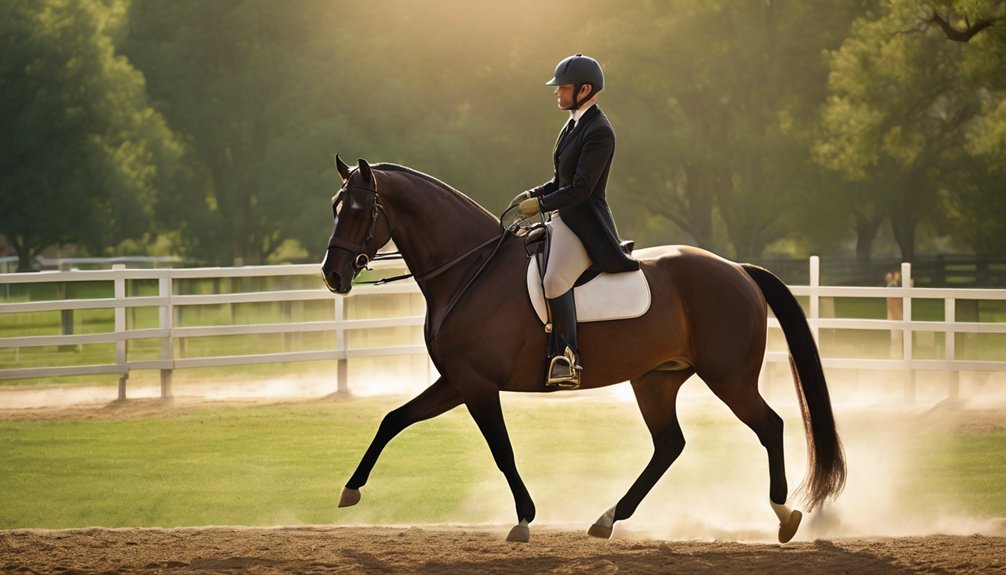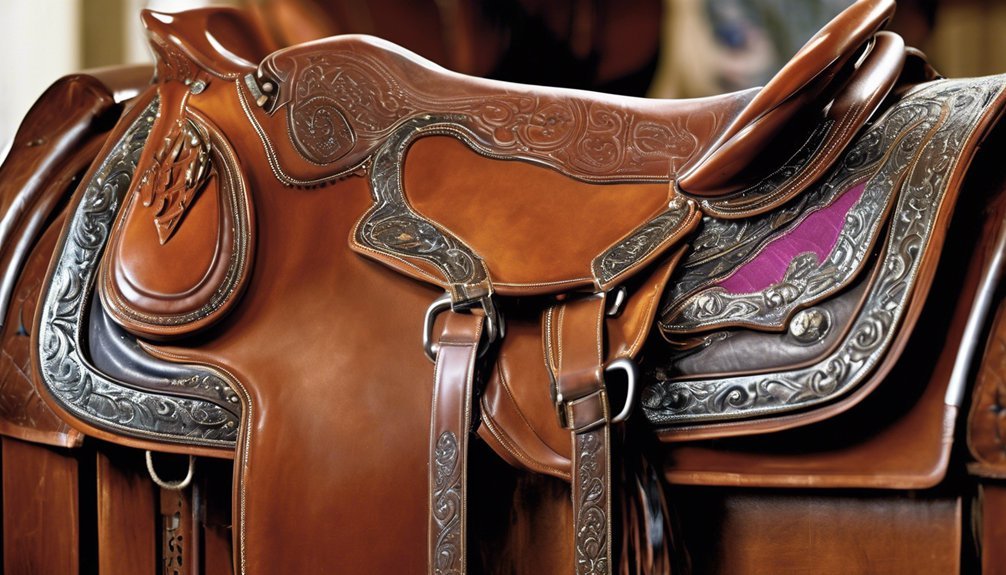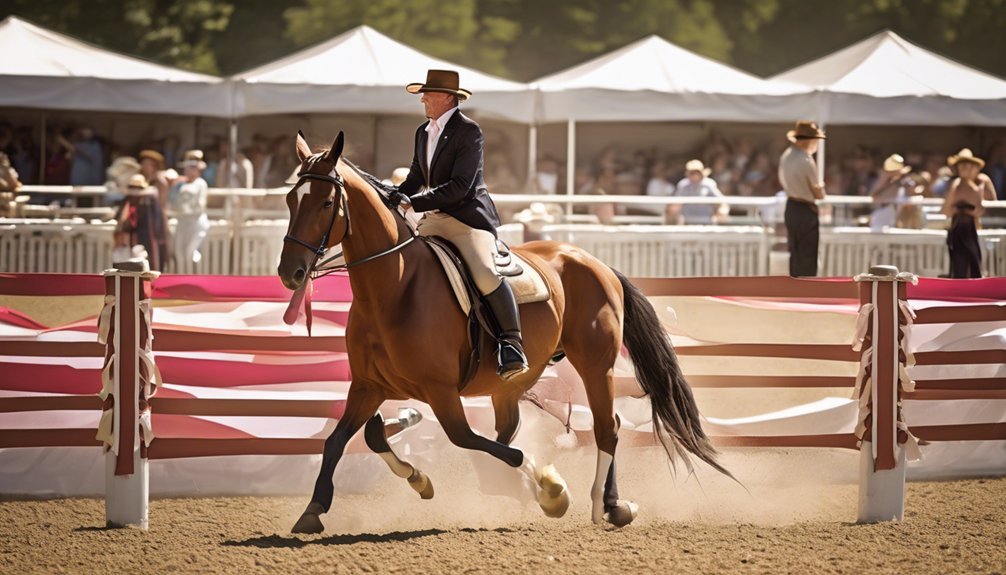
Improving your horse's gait for saddle seat competition is crucial for achieving that winning edge. It involves a blend of groundwork, lunging, and tailored fitness routines that enhance balance and rhythm. By assessing your horse's current gait and implementing specific exercises, you can make significant strides in their performance. The journey to a polished gait is multifaceted and requires careful attention to detail. Are you ready to explore the techniques that can elevate your horse's movement?
Key Takeaways
- Conduct a thorough gait analysis to identify strengths and weaknesses in rhythm, cadence, and balance.
- Engage in consistent groundwork exercises, like lunging and lateral movements, to enhance horse flexibility and responsiveness.
- Utilize lungeing techniques to promote hindquarter engagement, front elevation, and maintain a steady rhythm during training.
- Develop a structured fitness routine that includes interval training and hill work to improve strength and endurance.
- Regularly assess progress and adjust training strategies to ensure continued improvement and strengthen the bond with your horse.
Understanding the Importance of Gait in Saddle Seat Competition
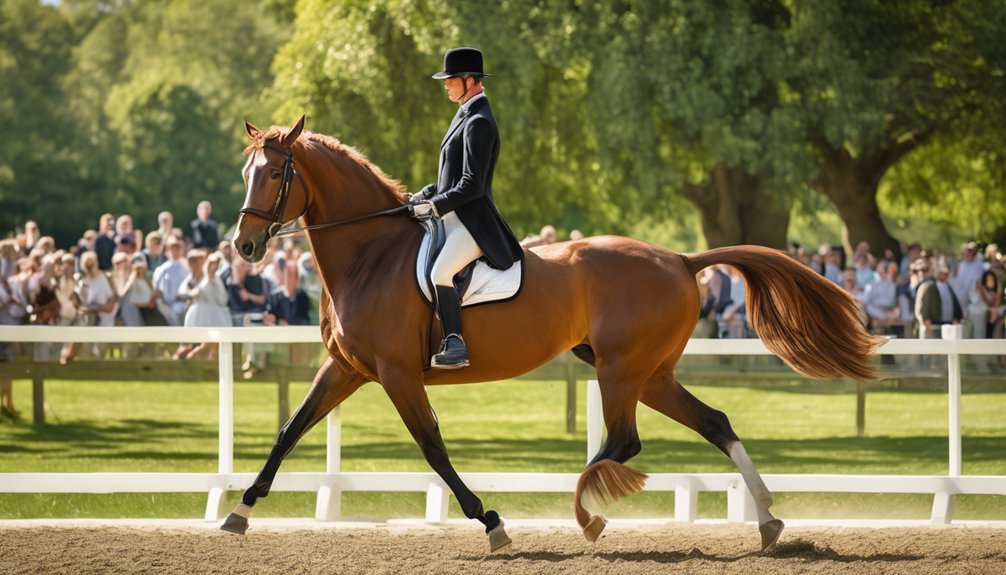
When you're preparing for saddle seat competition, understanding the importance of your horse's gait is crucial. Gait biomechanics play a significant role in how your horse moves and performs. Each stride must exhibit the smoothness and rhythm that defines saddle seat nuances.
Pay close attention to the way your horse transitions between gaits, as this affects both performance and overall impression in the ring. A well-executed gait not only showcases your horse's athleticism but also reflects your skills as a rider.
Assessing Your Horse's Current Gait
To improve your horse's performance in saddle seat competition, you first need to assess its current gait. Start by conducting a gait analysis, focusing on rhythm, cadence, and balance.
Observe your horse in motion, noting any irregularities or inconsistencies. A thorough movement evaluation will help you identify strengths and weaknesses in its gait.
Pay attention to how your horse carries itself and transitions between gaits. Ensure you assess both in-hand and under saddle to get a comprehensive view.
This process not only helps you understand your horse's capabilities but also strengthens your bond by fostering communication.
Basic Groundwork Exercises to Enhance Gait
Engaging in basic groundwork exercises is essential for enhancing your horse's gait, setting the stage for improved performance in saddle seat competition.
Start with groundwork techniques like lunging, which helps develop your horse's rhythm and balance. Incorporate exercises that encourage horse flexibility, such as bending and yielding to pressure. Use a halter and lead rope to guide them through serpentines and circles, promoting engagement of their core muscles.
Practicing lateral movements, like side-passing, can also improve their overall agility and responsiveness. Consistency is key; dedicate time each session to reinforce these exercises.
Utilizing Lungeing Techniques for Improved Movement

While lungeing may seem straightforward, mastering this technique can significantly enhance your horse's movement in saddle seat competition.
Start by establishing a clear line of communication with your horse; use consistent voice commands and body language to promote understanding.
Utilize lungeing techniques that encourage proper engagement of the hindquarters and elevation of the front end.
Focus on maintaining a steady rhythm and applying gentle pressure to guide your horse into a balanced trot or canter.
Incorporate transitions between gaits to develop responsiveness and flexibility.
Remember, patience is key—allow your horse to build muscle memory over time.
Incorporating Cavaletti and Pole Work
Incorporating cavaletti and pole work into your training regimen can significantly enhance your horse's gait and overall performance for saddle seat competition.
Start by setting up various cavaletti patterns that encourage your horse to lift its legs and engage its core. Experiment with pole placement to create obstacles that promote rhythm and balance.
For instance, placing poles at varying distances helps your horse develop a more fluid stride. Regularly practicing these exercises not only builds strength but also enhances coordination, which is crucial for competitive success.
Remember to maintain a positive atmosphere during training sessions, as this encourages your horse to respond better.
With dedication and consistency, your horse will shine in the show ring, showcasing its improved gait!
The Role of Proper Conditioning and Fitness
Proper conditioning and fitness play a crucial role in enhancing your horse's gait for saddle seat competition. To achieve optimal results, develop structured fitness routines that focus on building strength, flexibility, and endurance.
Incorporate varied conditioning plans, including interval training and hill work, to target specific muscle groups while improving cardiovascular health. Regular assessments will help you track progress and adjust your strategies as needed, ensuring your horse remains physically prepared.
Remember, a well-conditioned horse not only performs better in the ring but also enjoys the training process. By committing to a consistent fitness regimen, you foster a deeper bond with your horse, paving the way for success and shared achievements in competition.
Your dedication truly makes a difference!
Tailoring Your Tack for Optimal Performance
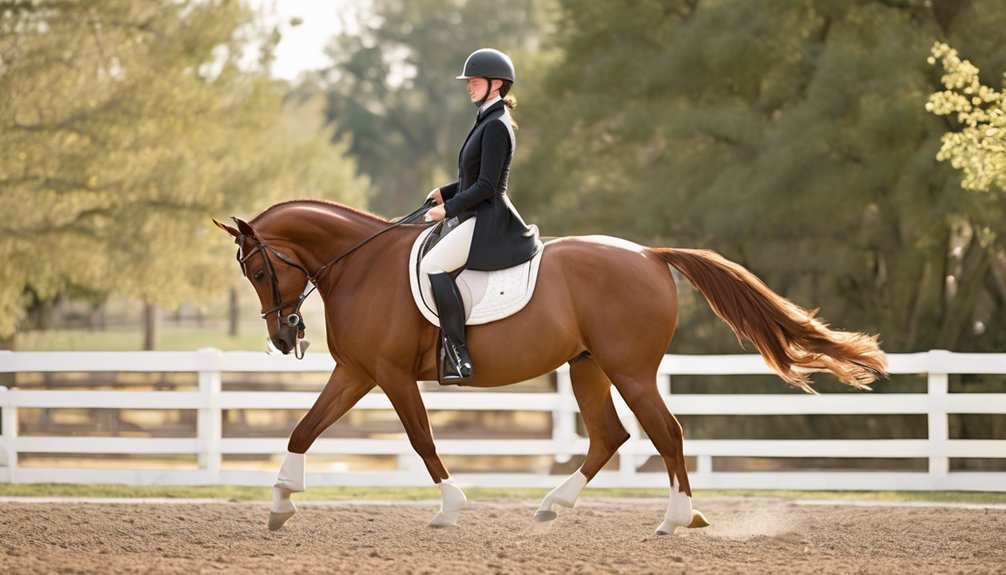
Choosing the right tack is essential for maximizing your horse's performance in saddle seat competitions.
Start with proper tack fitting; an ill-fitting saddle can hinder your horse's movement and comfort. Focus on saddle selection that not only complements your horse's build but also enhances their natural gait. Look for a saddle with a balanced tree and adequate wither clearance to allow for unrestricted shoulder movement.
The right girth and bridle should also support your horse's anatomy, improving their overall performance. Don't forget to consider the materials—lightweight options can help in maintaining agility.
The Impact of Rider Position and Aids
While maintaining an effective rider position is crucial, the way you use your aids can significantly influence your horse's gait in saddle seat competition.
Achieving proper rider alignment is essential; it ensures you're balanced and allows your horse to move freely. Pay attention to your seat, shoulders, and legs, as they all play a role in guiding your horse.
Use effective cues, such as gentle leg pressure or subtle rein adjustments, to communicate your intentions clearly. Strive for consistency in your signals, which helps your horse understand what you're asking.
Developing a Consistent Warm-Up Routine
Establishing a consistent warm-up routine is essential for preparing your horse for saddle seat competition, as it helps to physically and mentally ready both you and your horse.
Begin with a brisk walk to increase blood flow, followed by stretching exercises to enhance flexibility. Incorporate transitions between gaits to engage your horse's muscles and improve responsiveness.
These warm-up benefits contribute to better performance and reduce the risk of injury. Consistency in your routine is key; aim to replicate the same steps before each ride to create familiarity and comfort for your horse.
Monitoring Progress and Making Adjustments
As you work to improve your horse's gait for saddle seat competition, monitoring progress and making necessary adjustments is crucial for achieving optimal results.
Start by implementing progress tracking methods, such as keeping a journal of your training sessions. Note specific elements like stride length, rhythm, and responsiveness. This data will help you identify trends and areas needing attention.
When adjustments are needed, consider adjustment strategies like altering your warm-up routine or modifying your training exercises. If you notice your horse struggling with a particular gait, focus on targeted exercises that reinforce that movement.
Frequently Asked Questions
How Do I Choose the Right Saddle for My Horse's Gait?
To choose the right saddle, start with a thorough gait analysis. Ensure the saddle fit accommodates your horse's movement, allowing freedom and comfort. This'll enhance performance and strengthen your bond during rides. You've got this!
What Are Common Signs of Gait Issues in Saddle Seat Horses?
You might notice gait abnormalities like uneven strides or shortened stride length. Pay attention to your horse's movement; any signs of limping or stiffness can indicate underlying issues that need addressing for optimal performance.
Can Diet Affect My Horse's Gait Performance?
Just like us, your horse thrives on a balanced diet. Nutrient balance and the right dietary supplements can significantly enhance performance. Keep your horse's nutrition in check to see improvements in its overall gait and health!
What Is the Best Age to Start Gait Training?
You should start gait training around two to three years old, focusing on proper gait mechanics. Establish a consistent training schedule, ensuring your horse builds strength and coordination, fostering confidence and enhancing performance as they grow.
How Often Should I Consult a Veterinarian About My Horse's Gait?
Think of your horse's gait as a finely tuned instrument; regular veterinary check-ups ensure it plays in harmony. Aim for gait analysis every six months, adjusting as needed, to keep your horse in peak condition.
Conclusion
In conclusion, if you want your horse to strut its stuff like a showstopper, remember that hard work beats talent when talent doesn't work hard. By mastering the outlined techniques, you'll transform your horse's gait from "meh" to magnificent. So, grab those lunge lines and get to work! After all, no one wants to be that rider whose horse looks like it's auditioning for a role in a slow-motion nature documentary. Let's get moving!



